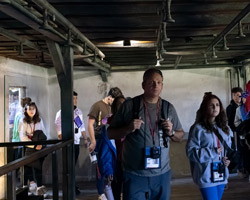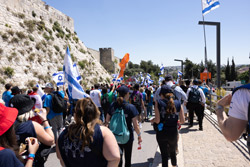
March of the Living Blog
Reflections from March of the Living
May 2023
By Peter Eckstein
Vice President, Jewish Education
Friedman Commission for Jewish Education at Jewish Federation of Palm Beach County
The reflections below were shared by Federation’s Peter Eckstein after he participated in 2023’s March of the Living with his mother, a Holocaust survivor and member of the Jewish Palm Beach community. In May 2024, a group from the Palm Beaches will travel to Poland and Israel for the march. If you are interested in learning more about participating in this journey, email peter.eckstein@jewishpalmbeach.org.
 Thirty-three empty chairs fill The Ghetto Heroes Square in Krakow, Poland. Each chair represents 1,000 lives lost during the Shoah – the Hebrew word used to describe the Holocaust. The chairs remind us of those who were assembled in that very location before being deported to the Auschwitz and Plaszow concentration camps. There is a theme that informs this display: “The Presence of Absence and the Absence of Presence.”
Thirty-three empty chairs fill The Ghetto Heroes Square in Krakow, Poland. Each chair represents 1,000 lives lost during the Shoah – the Hebrew word used to describe the Holocaust. The chairs remind us of those who were assembled in that very location before being deported to the Auschwitz and Plaszow concentration camps. There is a theme that informs this display: “The Presence of Absence and the Absence of Presence.”
Since I returned from March of the Living, I can’t help but reflect on how presence and absence defined my experience.
Why I Went

March of the Living is a two-week annual experience, primarily for teens. During the first week, participants bear witness to the destruction of European Jewry: visiting ghettos, death camps, railroad stations and cemeteries. The second week of the journey can be described as a metaphorical rebirth, as teens travel to Israel to celebrate Yom HaAtzmaut (Israel Independence Day).
By the end of these two weeks, teens come home energized with the spirit of Jewish peoplehood and connection to the State of Israel.
I participated in the March because my 87-year-old mother, a survivor of the Budapest Ghetto who has participated in this program twice before, decided to take part one more time. As I accompanied her as the son of a survivor, I also was responsible for a small pod of teens on the trip and our bus photographer. The teens on our bus were mostly from Palm Beach County, part of the Southern Region of The March of the Living.
Spitting in the Face of Hate
Krakow is the closest metropolitan center to the Auschwitz-Birkenau complex, about an hour’s drive away from the main entrance to Auschwitz, where The March began. We were among 10,000 teens and adults from all over the world who assembled on a road that ran through the middle of the death camp on Yom HaShoah, Holocaust Remembrance Day. A shofar was blown and we marched through the camp, bypassing the empty brick buildings that once held prisoners and torture chambers, past the crematoria and gas chamber located on one side of the camp. We marched in silent memory of those who were no longer present with us. We felt their absence viscerally.
As we passed under the infamous gate of Auschwitz, upon which emblazoned the infamous Arbeit Macht Frie (“Work Sets You Free”), a different spirit descended upon us. It was joyful… almost giddy. You see, in January 1945, the Nazi guards evacuated Birkenau, blowing up the crematoria and gas chambers, and marched the surviving inmates first to Auschwitz and then west – many to their deaths.
 My father, a Birkenau inmate, remembered that day. He understood that this was, in fact, a death march. He stayed behind with other survivors and awaited the Soviet Army that within a few days, conquered the area and liberated the camps.
My father, a Birkenau inmate, remembered that day. He understood that this was, in fact, a death march. He stayed behind with other survivors and awaited the Soviet Army that within a few days, conquered the area and liberated the camps.
That is the origin of the name: March of the Living. The modern march starts in Auschwitz and ends in Birkenau: the reverse route taken by the Death March – ergo, March of the Living. Rather than the despair of January 1945, there is a sense of defiance and pride. It is spitting in the face of hate.
The Power of Presence
As I walked the 3 kilometers between camps, I couldn’t help but be struck by the pizza parlor on the corner outside the gates of Auschwitz and signs for grocery stores and KFC located nearby. Is this a desecration of the memory of those who are absent, or is the presence of these icons to modernity to be expected, or even celebrated?



Part of the curriculum underlying March of the Living includes fostering an emotional attachment to the memories of those who died. Participants were given wooden paddles (they look like table tennis rackets) upon which they were asked to write the name of a victim of the Shoah. Before entering Birkenau, we came upon the railroad tracks that brought the victims to their final stop. It was covered with these memorial paddles. Stuck into the stone and earth between the railroad ties was the presence of those who are absent.Once you pass under the “Death Gate” into Birkenau, you are struck by the surrealism that lies before you. On one side, all you see are chimneys – all that is left of the wooden prisoner barracks. Running through the middle of the camp lie the train tracks that brought the victims to their final stop. On the other side of the tracks lie the women’s barracks, still intact, as they are made of brick.
 Walking along the tracks, you encounter the remains of crematoria and gas chambers that were destroyed by the Nazis as they evacuated the camp. Today, these are piles of bricks and stones. As I gazed upon them, a sense of horror engulfed me as I came to the realization that this was the site where my entire family on my father’s side was murdered and burned. This is the closest I will ever get to the Ecksteins of Etyek, Hungary.
Walking along the tracks, you encounter the remains of crematoria and gas chambers that were destroyed by the Nazis as they evacuated the camp. Today, these are piles of bricks and stones. As I gazed upon them, a sense of horror engulfed me as I came to the realization that this was the site where my entire family on my father’s side was murdered and burned. This is the closest I will ever get to the Ecksteins of Etyek, Hungary.
Staring at Horror
 My mother is a teacher – not by profession, but by virtue of being a survivor. Her mission in life is to instill in the next generation the lessons of the Shoah. “Never forget,” she says. Not because it can happen to Jews (it might) – but because can happen to anyone, whether they are Jew, Black or Trans. That is why she and other survivors subject themselves to this painful trek. They tell their stories. They connect with a younger generation. And they support the young people when they come face to face with true horror.
My mother is a teacher – not by profession, but by virtue of being a survivor. Her mission in life is to instill in the next generation the lessons of the Shoah. “Never forget,” she says. Not because it can happen to Jews (it might) – but because can happen to anyone, whether they are Jew, Black or Trans. That is why she and other survivors subject themselves to this painful trek. They tell their stories. They connect with a younger generation. And they support the young people when they come face to face with true horror.
This brings us to Majdanek, a still intact death camp right outside the eastern Polish city of Lublin. The gas chambers, the crematoria, and the barracks are all standing and bear silent witness to the 100,000 or more Jews and other humans who were destroyed there. We walked into the disinfectant building, passing through the narrow hall into a shower room. With shower fixtures. They were real. The Nazis realized that Zyklon B gas was more effective in killing people if they were wet. We passed under the fixtures into a large rectangular room: the gas chamber. On the walls of this killing room, we saw scratches in the concrete left behind by the dying as they were literally attempting to crawl out of this hell. The teens walked out of the building, and some collapsed in tears. The survivors were there to catch them and hold them and give them space to mourn those who were now absent.


But this wasn’t the worst. Next to the crematorium is a domed structure called “the Mausoleum.” Under its roof lies an enormous pile of human ash mixed with dirt. This mound was meant to be composted to grow a vegetable garden in the camp. There are still bones in it. This is what is left of the victims of Majdanek.
The silent screams are deafening. And even after leaving the camps, they are always present.
Israel as Home

After a week in Poland, we traveled to Israel, leaving Warsaw just before midnight and arriving in Tel Aviv to see the sunrise. The cold and dark of Poland was replaced by Mediterranean warmth and a celebratory homecoming. Imagine 10,000 human beings marching through the streets of Jerusalem, singing and laughing as they climb the steps into the Old City’s Jewish Quarter and ultimately to the Western Wall. If Poland was the story of sadness and evil, Israel became the response. It was framed as the narrative of pride and power. “Never again will we be victims” was the mantra that was repeated.
We celebrated Jewish pride and power, as exemplified by the State of Israel. As one of the March of the Living educators told me, the point is for the teens to leave Israel knowing and feeling that Israel is their home.

Lessons of Catastrophe
The word Holocaust means sacrifice. I did not sacrifice my aunt and cousins and grandparents. They were murdered. It was a catastrophe, which is what the word Shoah means. Their absence is a presence in my soul.
I’m a Jewish educator. That is how I honor my family members who were consumed in the fire of hatred and intolerance. It sounds trite, but Santayana was right: If we ignore the past, it will come back to haunt us. Therefore, I teach so others will remember and, if necessary, fight when injustice returns. For me, that is the true lesson of the March of the Living.
>> Click here to see upcoming travel experiences
>> Click here to learn more about local learning programs, including Israel-themed experiences.






